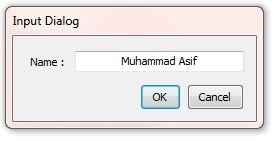Have you ever tried looking for a Input Dialog box in C#? I did recently and fully expecting something similar to the MessageBox.Show() found out that there wasn’t one. So I browsed the web for a quick solution, and did’nt find exactly what I wanted so I decided to make my own. Here is how I did it for those of you facing the same problem.
Just to be clear, my goals were :
- Simple looking dialog, with caption, description, and a textbox.
- Option to press ok and also cancel out.
- Easy way to return the value.
Okay lets start, create a form named InputDialog.cs with the following code in InputDialog.Designer.cs but make sure you rename the namespace to your own :
namespace InputDialogExample // <--- you must change this!
{
partial class InputDialog
{
/// <summary>
/// Required designer variable.
/// </summary>
private System.ComponentModel.IContainer components = null;
/// <summary>
/// Clean up any resources being used.
/// </summary>
/// <param name="disposing">true if managed resources should be disposed; otherwise, false.</param>
protected override void Dispose(bool disposing)
{
if (disposing && (components != null))
{
components.Dispose();
}
base.Dispose(disposing);
}
#region Windows Form Designer generated code
/// <summary>
/// Required method for Designer support - do not modify
/// the contents of this method with the code editor.
/// </summary>
private void InitializeComponent()
{
this.tblLayout = new System.Windows.Forms.TableLayoutPanel();
this.txtInput = new System.Windows.Forms.TextBox();
this.lblInput = new System.Windows.Forms.Label();
this.btnOk = new System.Windows.Forms.Button();
this.btnCancel = new System.Windows.Forms.Button();
this.tblLayout.SuspendLayout();
this.SuspendLayout();
//
// tblLayout
//
this.tblLayout.ColumnCount = 2;
this.tblLayout.ColumnStyles.Add(new System.Windows.Forms.ColumnStyle());
this.tblLayout.ColumnStyles.Add(new System.Windows.Forms.ColumnStyle());
this.tblLayout.Controls.Add(this.lblInput, 0, 0);
this.tblLayout.Controls.Add(this.txtInput, 1, 0);
this.tblLayout.Location = new System.Drawing.Point(12, 12);
this.tblLayout.Name = "tblLayout";
this.tblLayout.RowCount = 1;
this.tblLayout.RowStyles.Add(new System.Windows.Forms.RowStyle(System.Windows.Forms.SizeType.Percent, 100F));
this.tblLayout.Size = new System.Drawing.Size(222, 27);
this.tblLayout.TabIndex = 0;
//
// txtInput
//
this.txtInput.Dock = System.Windows.Forms.DockStyle.Fill;
this.txtInput.Location = new System.Drawing.Point(50, 3);
this.txtInput.Name = "txtInput";
this.txtInput.Size = new System.Drawing.Size(169, 21);
this.txtInput.TabIndex = 0;
this.txtInput.TextAlign = System.Windows.Forms.HorizontalAlignment.Center;
this.txtInput.TextChanged += new System.EventHandler(this.txtInput_TextChanged);
//
// lblInput
//
this.lblInput.AutoSize = true;
this.lblInput.Dock = System.Windows.Forms.DockStyle.Fill;
this.lblInput.Location = new System.Drawing.Point(3, 0);
this.lblInput.Name = "lblInput";
this.lblInput.Size = new System.Drawing.Size(41, 27);
this.lblInput.TabIndex = 1;
this.lblInput.Text = "Name :";
this.lblInput.TextAlign = System.Drawing.ContentAlignment.MiddleLeft;
//
// btnOk
//
this.btnOk.AutoSize = true;
this.btnOk.DialogResult = System.Windows.Forms.DialogResult.OK;
this.btnOk.Enabled = false;
this.btnOk.Location = new System.Drawing.Point(127, 48);
this.btnOk.Name = "btnOk";
this.btnOk.Size = new System.Drawing.Size(41, 26);
this.btnOk.TabIndex = 1;
this.btnOk.Text = "&OK";
this.btnOk.UseVisualStyleBackColor = true;
this.btnOk.Click += new System.EventHandler(this.btnOk_Click);
//
// btnCancel
//
this.btnCancel.AutoSize = true;
this.btnCancel.DialogResult = System.Windows.Forms.DialogResult.Cancel;
this.btnCancel.Location = new System.Drawing.Point(174, 48);
this.btnCancel.Name = "btnCancel";
this.btnCancel.Size = new System.Drawing.Size(57, 26);
this.btnCancel.TabIndex = 2;
this.btnCancel.Text = "&Cancel";
this.btnCancel.UseVisualStyleBackColor = true;
//
// InputDialog
//
this.AcceptButton = this.btnOk;
this.AutoScaleDimensions = new System.Drawing.SizeF(6F, 13F);
this.AutoScaleMode = System.Windows.Forms.AutoScaleMode.Font;
this.CancelButton = this.btnCancel;
this.ClientSize = new System.Drawing.Size(243, 85);
this.ControlBox = false;
this.Controls.Add(this.btnCancel);
this.Controls.Add(this.btnOk);
this.Controls.Add(this.tblLayout);
this.Font = new System.Drawing.Font("Tahoma", 8.25F, System.Drawing.FontStyle.Regular, System.Drawing.GraphicsUnit.Point, ((byte)(0)));
this.FormBorderStyle = System.Windows.Forms.FormBorderStyle.FixedDialog;
this.Name = "InputDialog";
this.StartPosition = System.Windows.Forms.FormStartPosition.CenterParent;
this.Text = " Input Dialog";
this.tblLayout.ResumeLayout(false);
this.tblLayout.PerformLayout();
this.ResumeLayout(false);
this.PerformLayout();
}
#endregion
private System.Windows.Forms.TableLayoutPanel tblLayout;
private System.Windows.Forms.Label lblInput;
private System.Windows.Forms.TextBox txtInput;
private System.Windows.Forms.Button btnOk;
private System.Windows.Forms.Button btnCancel;
}
}
Now you should have a form that looks like this :
Now this form needs some code behind it to function, so clear everything behind it and paste the following :
using System;
using System.Windows.Forms;
namespace InputDialogExample // <--- you must change this!
{
public partial class InputDialog : Form
{
string input_text;
public string ResultText
{
get { return input_text; }
private set { input_text = value; }
}
public InputDialog(string title, string label_text, string textbox_string)
{
InitializeComponent();
this.Text = title;
this.lblInput.Text = label_text;
this.txtInput.Text = textbox_string;
}
public InputDialog()
{
InitializeComponent();
}
private void txtInput_TextChanged(object sender, EventArgs e)
{
if (txtInput.Text.Trim().Length > 0)
{
btnOk.Enabled = true;
}
else
{
btnOk.Enabled = false;
}
}
private void btnOk_Click(object sender, EventArgs e)
{
ResultText = txtInput.Text.Trim();
}
}
}
Congratulations! The input dialog is done. Use the code below to show it, and fetch the result from it :
InputDialog dialog = new InputDialog("Caption Here", "Label Text Here", "Default Textbox String");
if (dialog.ShowDialog() == DialogResult.OK)
{
string result_text = dialog.ResultText;
// use result_text...
}
else
{
// user cancelled out, do something...
}
Thats it! Inshaa’Allah (God Willing) this article was helpful to you.
— Muhammad

